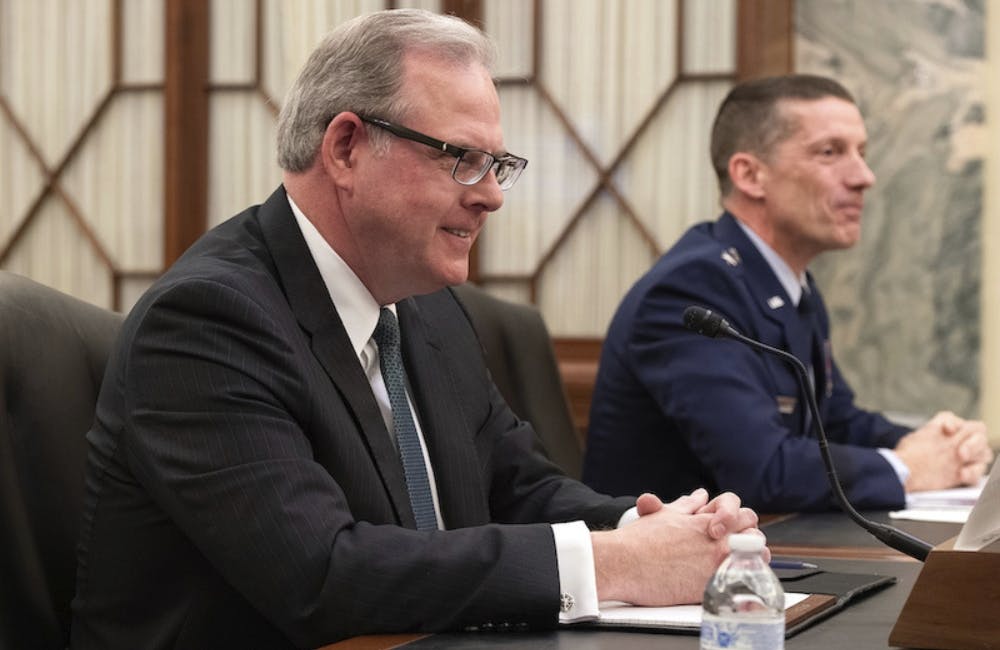Tech Developments at DOD to Watch in 2024
Zero trust, AI and hybrid cloud were on the minds of defense tech leaders this year.

The Defense Department’s technology portfolio is among the largest in the world. Zero trust, artificial intelligence and hybrid cloud dominated tech conversations and will support ongoing priorities as the agency embarks on a new year. These efforts are part of broader technology initiatives to connect the military services and operate jointly across domains — all of which underpin the newly renamed Combined Joint All-Domain Command Control (CJADC2) concept.
Services Weigh Zero Trust Implementation
One year after the release of the Defense Department’s five-year zero-trust strategy and execution roadmap in 2022, service branches began submitting their zero-trust implementation plans for review.
The Zero Trust Portfolio Management Office has just received more than 40 implementation plans from military services and defense agencies. The office is expected to finish evaluating those submissions in before the end of 2023.
“We came out with our zero-trust strategy, which was a really big deal … it was the first time the DOD expressed what they wanted in zero trust and described the level we needed to achieve. And one year after the strategy, it was a requirement to actually submit an implementation plan,” Randy Resnick, director of the office, told GovCIO Media & Research at AFCEA TechNet Indo-Pacific in November. “This is a really big change for everybody, … but what I saw when I reviewed it, I was very pleased with the content. … It’s a big move from the cyber perspective.”
A rapid shift to artificial intelligence and cloud-based technologies, remote work and technical debt are only some of the factors contributing to an increased security threat environment for DOD. To address the constantly evolving cybersecurity challenges, military service branches have until fiscal year 2027 to achieve target level zero-trust readiness.
Since military services and components are delivering their implementation plans with different solutions to meet their specific mission needs, Resnick’s challenge is to ensure that everyone is synchronized throughout the process.
“We wanted the components to choose how to get the target level. But some of them are doing it in different ways, and the hard part for our portfolio offices is to keep track of all of this. So it’s about actual procurement in the actual implementation,” Resnick said.
By the end of fiscal year 2024, Resnick’s office expects services and components to start buying solutions.
“Once we approve, we are expecting them to make procurements happen. And that’s when they’re going to start engaging heavily with the vendors. Contracts are going to be established. … That’s when really the hardware software hits the ground, and applications, users and data start moving,” Resnick said.
The Pentagon is also required to brief Congress in January 2024 on how the department plans to achieve zero trust target level readiness by 2027.
During this transition, the Defense Information Systems Agency (DISA) is helping military services to move away from the legacy castle-and-moat cybersecurity approach through its Thunderdome initiative.
DISA’s Thunderdome program led to a $1.86 billion contract with Booz Allen Hamilton to move from prototype to production. Some service branches and components will partner with DISA in the coming year to evaluate whether Thunderdome is a viable option for them to protect networks.
Artificial Intelligence Dominates
To advance modernization efforts with AI adoption, the Pentagon established the Chief Digital and Artificial Intelligence Office (CDAO) in 2022. In November, the office released its new AI strategy focusing on agile AI implementation across the enterprise.
The new strategy followed the White House’s long-awaited artificial intelligence executive order that seeks to reduce and manage national security risks posed by the technology.
The strategy is meant to provide a foundation and unified approach for data, analytics and AI adoption across all military services, assembling an educated workforce to incorporate commercial tools and advancing research of the nascent technology.
“Our integration of data, analytics and AI technologies is nested within broader U.S. government policy, the network of private sector and academic partners that promote innovation, and a global ecosystem. We need a systematic, agile approach to data, analytics and AI adoption that is repeatable by all DOD Components,” according to the strategy.
For fiscal year 2024, the Pentagon requested $1.8 billion for artificial intelligence, a $600 million increase from $1.2 billion the department requested for the previous year.
As the Pentagon is scaling up its use of artificial intelligence, the need for the department to do so responsibly and ethically is critical.
In November, the CDAO released the Responsible Artificial Intelligence (RAI) Toolkit, a key deliverable of its Responsible AI Strategy and Implementation Pathways released in 2022. The toolkit is meant to provide a centralized process for identifying and enhancing the alignment of the department’s AI projects and the AI ethical principles.
“We reach for the opportunity that AI provides us with what we need to reach with the other hand and manage the risks that will come with the application of that disruptive technology,” Coast Guard Vice Adm. Kevin Lunday said at the 2023 Sea-Air-Space conference at National Harbor, Maryland, earlier this year.
With the release of the artificial intelligence executive order, the White House wants DOD to address gaps in AI talent, assess ways AI can increase biosecurity risks and complete an operational pilot project to deploy AI capabilities, including large language models.
“If the White House and executive branch achieve even half of the provisions, it will be a vital step forward to safeguard AI,” Heather Frase, senior fellow of AI assessment at Georgetown University’s Center for Security and Emerging Technology, told GovCIO Media and Research.
Hybrid Cloud and Edge Computing Advance
Pentagon CIO John Sherman August memo mandated the services to use the Joint Warfighting Cloud Capability (JWCC) contract to purchase cloud capabilities and services across all classification levels moving forward.
DOD’s $9 billion multi-vendor cloud contract marks a new era for the DOD cloud efforts. It was launched after its failed predecessor, JEDI, was awarded to Amazon, Google, Microsoft and Oracle in December 2022.
While the JWCC is not the “end all be all” of the DOD cloud, this work is critical to provide cloud capabilities at the secret and top-secret classification levels, as well as extending the cloud to the edge environments to provide a more resilient infrastructure outside the contiguous United States.
“How do we extend what today is primarily a CONUS-based cloud infrastructure with a few edge nodes that the military departments have been bringing out themselves, and how do we move the enterprise out to the edge out to the battle space to provide a more resilient infrastructure, more responsive infrastructure, and give us data processing and AI capabilities directly within theater? That’s that a big step that we’re working on,” Rob Vietmeyer, DOD’s chief software officer, told GovCIO Media and Research.
DISA, the agency leading the procurement effort, announced in October that DOD awarded 13 different cloud task orders that are worth over $200 million under the JWCC contract. Some of the task orders service the department’s CJADC2 initiative. More than a dozen orders are also in the works.
The program plan is a three-year base contract with two one-year options, which means that the work will possibly be conducted through 2028. At the end of the five-year procurement period, the Pentagon will launch “a full and open competition for a future multi-cloud acquisition.”
5G Connectivity
The Pentagon recently said it will shift 5G-related efforts from the Undersecretary of Defense (USD) for Research and Engineering’s FutureG and 5G Office to the CIO. The shift marks a key time when there is a growing need for the expansion of 5G pilot programs that will advance implementation for the wireless capability.
The FutureG & 5G Office focused its efforts on three areas to advance the Pentagon’s modernization efforts:
-
The “accelerate” portion of the initiative focuses on advancing the Defense Department’s adoption of 5G.
-
The “operate through” part concentrates on ensuring the secure use of 5G.
-
The “innovate” area of the initiative works on investing in NextG technologies.
Since 2020, the Pentagon invested $600 million in 5G development at nine military test sites around the continental U.S. Two of the test sites, Naval Base San Diego in California and Marine Corps Logistics Base Albany in Georgia, have been working on 5G-enabled smart warehouses.
Sherman said his office wants to expand the existing programs, possibly add more 5G installations, including an open radio access network (O-RAN).
“The technology has really matured to a point where it’s … almost imperative for DOD to work with this and to understand how we can interact with what we call the ‘global information infrastructure.’ This is the worldwide connectivity of everything. How do we not participate and how do we not utilize what’s been produced out there in the commercial world?” Dr. Tom Rondeau, principal director for FutureG & 5G at the Pentagon’s Office of the Undersecretary of Defense for Research and Engineering, told GovCIO Media and Research.
This is a carousel with manually rotating slides. Use Next and Previous buttons to navigate or jump to a slide with the slide dots
-

The CAIOs Leading Responsible AI Development Across Government
Since the White House's AI executive order, federal agencies are in the process of naming chief artificial intelligence officers.
7m read -

How TMF is Helping Agencies Accelerate Tech Modernization
The program launched a new AI pilot to expedite TMF applications as agency leaders urge more to consider applying for funds.
4m read -

Defense Board to Pitch Solutions for Closing Tech Talent Gaps
Defense Innovation Board members cite need to modernize people management the same way government modernizes technology.
4m read -

Energy Researchers Aim For Holistic Approach to AI Issues
A new center at the Oak Ridge National Laboratory is looking at under-researched areas of AI to better understand how to secure it.
2m read








